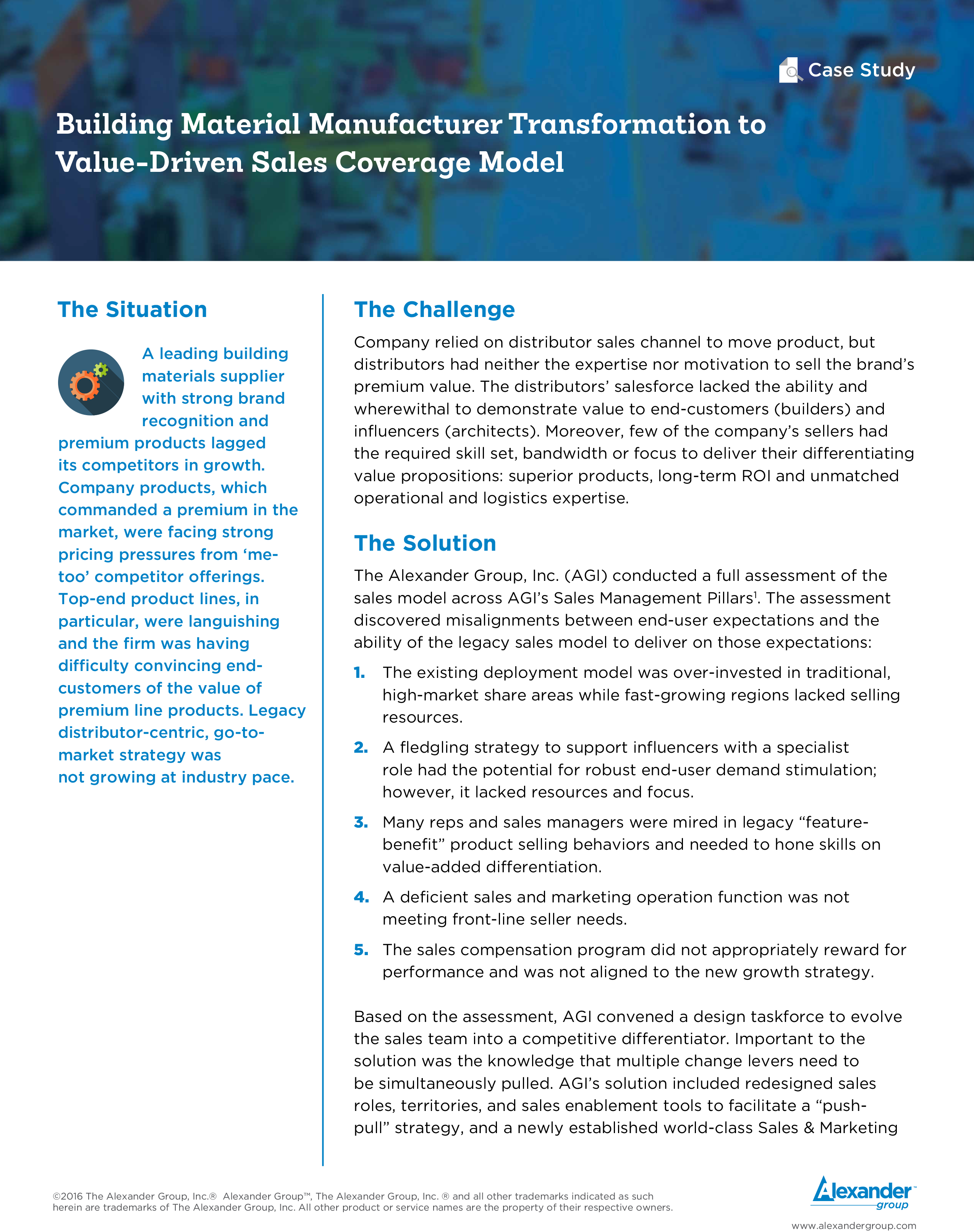Building Material Manufacturer Transforms Sales Coverage Model
 Situation: A leading building materials supplier with strong brand recognition and premium products lagged its competitors in growth. Company products, which commanded a premium in the market, were facing strong pricing pressures from ‘me-too’ competitor offerings. Top-end product lines, in particular, were languishing and the firm was having difficulty convincing end-customers of the value of premium line products. Legacy distributor-centric, go-to-market strategy was not growing at industry pace.
Situation: A leading building materials supplier with strong brand recognition and premium products lagged its competitors in growth. Company products, which commanded a premium in the market, were facing strong pricing pressures from ‘me-too’ competitor offerings. Top-end product lines, in particular, were languishing and the firm was having difficulty convincing end-customers of the value of premium line products. Legacy distributor-centric, go-to-market strategy was not growing at industry pace.
Challenge: Company relied on distributor sales channel to move product, but distributors had neither the expertise nor motivation to sell the brand’s premium value. The distributors’ salesforce lacked the ability and wherewithal to demonstrate value to end-customers (builders) and influencers (architects). Moreover, few of the company’s sellers had the required skill set, bandwidth or focus to deliver their differentiating value propositions: superior products, long-term ROI and unmatched operational and logistics expertise.
Solution: AGI conducted a full assessment of the sales model across AGI’s Sales Management Pillars1. The assessment discovered misalignments between end-user expectations and the ability of the legacy sales model to deliver on those expectations:
- The existing deployment model was over-invested in traditional, high-market share areas while fast-growing regions lacked selling resources
- A fledgling strategy to support influencers with a specialist role had the potential for robust end-user demand stimulation; however, it lacked resources and focus.
- Many reps and sales managers were mired in legacy “feature-benefit” product selling behaviors and needed to hone skills on value-added differentiation.
- A deficient sales and marketing operation function was not meeting front-line seller needs.
- The sales compensation program did not appropriately reward for performance and was not aligned to the new growth strategy.
Based on the assessment, AGI convened a design taskforce to evolve the sales team into a competitive differentiator. Important to the solution was the knowledge that multiple change levers need to be simultaneously pulled. AGI’s solution included redesigned sales roles, territories, and sales enablement tools to facilitate a “push-pull” strategy, and a newly established world-class Sales & Marketing Ops team to support the multi-channel sales strategy. Dashboards, training programs and competency models were developed along with motivating compensation plans that aligned with the new strategy. The company reinforced the transformation with sales playbooks and quantitative analysis.
Benefit: The sales transformation initiative enabled the company to achieve almost immediate, accelerated growth — within three months of launch the organization was outperforming the market for the first time in seven years. Having established an attitude of winning and perpetual evolution, the sales team is now poised to quickly adjust to changing market conditions and product launches. Using the new customer-centric opportunity model, leadership is able to identify the highest potential opportunities. The company was also able to build greater dealer commitment/loyalty.